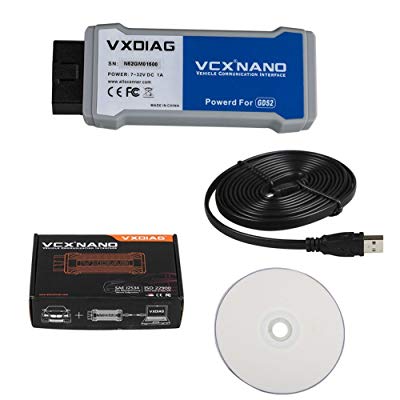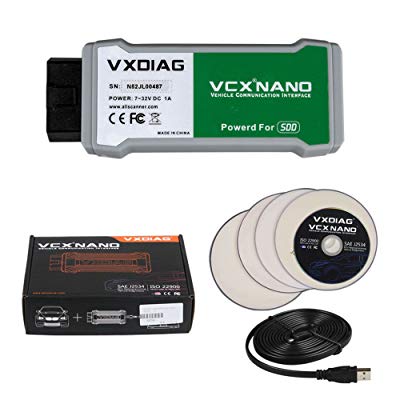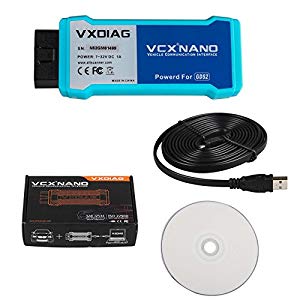Top VXDIAG VCX Nano Scanners Review 2018



Top VXDIAG VCX Nano Scanners: Review 2018
Planning to buy a diagnostic scanner? The VXDIAG VCX Nano line of scanners offers some of the best options for diagnostic products. It’s safe to say each and every one of them is a top-quality tool for scanning a vehicle’s onboard systems.
A VXDIAG VCX Nano is basically a PC-to-vehicle interface. It plugs into a vehicle’s OBD2 port and then connects to a PC. The connection can either be wired (via USB cable) or wireless (via Wi-Fi).
Either way, once a connection is established the scanner will be able to run various diagnostic functions like reading DTCs, resetting systems, adaptations, programming, actuation etc.
Note that VXDIAG VCX Nanodevices rely on diagnostic applications to carry out their functions. For example, while the VXDIAG VCX Nano GDS2 and Tech2Win come with GDS2 and Tech2Win software, VXDIAG VCX Nano JLR SDD comes with SDD.
On this page, we review three of the best VXDIAG VCX Nano scanners. But first, you will get a summary in form of a comparison table followed by a comprehensive buying guide.
Best VXDIAG VCX NANO Products Review
1. VXDIAG VCX Nano GDS2 and Tech2Win Diagnostic Programming System for GM/Opel

Like all other VXDIAG VCX Nano boxes, this particular unit acts as an interface between your vehicle and PC. It doesn’t use Wi-Fi or any form of wireless connection and instead connects to a vehicle’s computer using a cable.Depending on the OBD2 interface of your vehicle, this scanner will offer functions like DTC error codes, relearn, advanced reset and so much more. It comes with a program that installs on a computer. From there you can use the GDS2 and Tech2Win applications.
Compatibility
So which vehicles does this VXDIAG VCX Nanotool support? That would be GM and Opel models.
It is fully compatible with all the current and most legacy protocols. They include
- CAN
- Class2
- GM LAN
- KW2000
- UART
- SAE-J2534-1
- SAE-J2534-2
With regards to applications, first, it supports PC-based diagnostics that rely on Global Diagnostic System &nD-A-Sh; both GDS and GDS2. Additionally, it works with Tech2Win, a diagnostics platform for GM vehicles.
Note, however, that this VXDIAG VCX Nano will only work with Tech2Win when its software is installed on a 32-bit PC. That goes for Windows 7 as well as Windows 10.
As far as diagnostics, you can use it with third-party diagnostic applications that scan any system in a vehicle. Whether it diagnoses the engine, ABS,SRS, transmisson, instrument panels and what have you, it’s almost certain this device will work with it.
Connectivity
On one end the adapter features a port that hooks directly to the vehicle. The other end has a USB port. That’s what you use to connect the VXDIAG VCX Nano to a computer.
The connection will enable the vehicle and PC to communicate while using the adapter as an interface. You can use Windows XP or a later version. Note that in case you’re running Windows 7 or 10 the machine needs to be a 32-bit.
Functional features
By supporting vehicle protocols (CAN, Class2, GM LAN, KW2000, UART, etc.) and standards (SAE-J2534-1 and SAE-J2534-2 standards), this VXDIAG VCX Nano box makes it possible to do vehicle maintenance and generate service reports.
The GDS2 software specifically supports diagnostic functions. You can read and clear codes, freeze frame data, retrieve VIN and ECU information, manage output control functions, and retrieve the diagnostic history of a vehicle.
While the device also supports service programming system (SPS), you will need to purchase a software subscription for that.
On its part, Tech2Win offers almost all the features of GM’s Tech2. That includes PIDs, graphing, programming and reprogramming of modules.
Size
A compact device, this VXDIAG VCX Nano is a pocket-size gadget. It measures 8.3 x 6.3 x 1.9 inches and weighs 9.6 ounces.
Pros and Cons
Pros
Very affordable price tagStable software that activates and functions without issues
Compatible with both GDS2 and Tech2Win.
Supports wide array of vehicle protocols, which makes it ideal for mixed fleet use.
Easy to attach to vehicle’s diagnostic connector.
Multilingual menus.
Cons
To get programming functions you need to buy GM subscription.Some customers have reported problems when installing software.
Who is it built for?
Despite the advanced functionality, this VXDIAG VCX Nano is actually very simple to use. It is designed for the ordinary car owner. With it, you can diagnose various onboard systems and do relearn as well as advanced reset.
2. VXDIAG VCX Nano GDS2 and Tech2Win Diagnostic Programming System for GM/Opel Wifi Version

Save for connectivity, this Wi-Fi version of the VXDIAG VCX Nano is similar to the cable version. They are both interfaces that link a vehicle’s computer system with a PC. Plus they both enable diagnostic functions like DTC error codes, relearn, advanced reset etc.
The biggest difference is how they connect to a computer. While the cable version uses a cable (obviously), this one uses a wireless connection (Wi-Fi). But it does come with a USB cable just in case you prefer a cable connection.
Once connected to a computer you can use GDS2 and Tech2Win applications.
Compatibility
It is a GM/Opel adapter that connects to the OBD2 port. The device is compatible with all current and most legacy protocols like
- CAN
- Class2
- GM LAN
- KW2000
- UART
- SAE-J2534-1
- SAE-J2534-2
Like the cable version, this adapter is compatible with the Global Diagnostic System (GDS2) as well as Tech2Win. In fact, you get both when you make the purchase.
Besides that, it also supports third-party applications that run diagnostic functions for all onboard systems. Which means if you have the device you can diagnose the engine, ABS, SRS, transmission, instrument panels and so much more.
Connectivity
Now, this is where the Wi-Fi version of VXDIAG VCX Nano boasts unique features. Instead of connecting to a PC using a USB cable, it does so wirelessly using Wi-Fi.
So how it works is that the OBD2 port of the adapter hooks to the OBD2 port of a vehicle. And instead of using a USB cable to link the adapter to a computer you simply use Wi-Fi. That will enable the computer to communicate with the vehicle’s computer systems.
As you might already suspect, the computer must be Wi-Fi enabled. But in the package is a USB cable for those who don’t fancy a wireless connection. Also noteworthy is that the VXDIAG VCX Nano installs in a Windows XP or Windows 7 (strictly 32-bit) computer.
Functional features
You can use the VXDIAG VCX Nano WiFi version for various diagnostic functions thanks to the GDS2 and Tech2Win applications.
Specifically, GDS2 makes it possible to carry out diagnostic functions. They include read and clear trouble codes, freeze frame data, retrieving VIN and ECU information, managing output control functions, and retrieving the diagnostic history of a vehicle. You can also purchase the subscription for service programming system (SPS).
On the other hand, Tech2Win is excellent for PIDs, graphing, programming and reprogramming of modules. It is ideal for road tests.
Size
With dimensions of 7.4 x 6.4 x 1.9 inches and weight of 9.8 ounces, the VXDIAG VCX Nano WiFi adapter is a highly portable and easy-to-store device.
Pros and Cons
Pros
Software installs easily.Broad range of diagnostic functions, some of which are not supported by generic scan tools.
Firmware is updated online.
Works on virtually all GM and Opel vehicles, including SUVs and light trucks.
Pocket-sized, which is easily portable.
Cons
Only works on GM and Opel vehicles, other models are not supported.Programming and reprograming requires a different software which you have to purchase through subscription.
Who is it built for?
This OBD2 scanner has the same target audience as the VXDIAG VCX Nano with a cable. It is a straightforward scan tool for use by the ordinary car owner. Besides codes, it will help you perform more advanced functions like relearn, advanced reset etc.
3. VXDIAG VCX Nano JLR SDD Diagnostic Programming Tool for Jaguar and Land Rover

The VXDIAG VCX Nano JLR SDD for Jaguar and Land Rover comes as a full package. In the box, you will find the VXDIAG VCX Nano main unit, a USB cable and a CD with the unit’s software.
You will need to install the software on a PC. It’s a pretty simple and straightforward process. Once complete, plug the adapter into your vehicle’s OBD2 port.
After that, connect its other end with a USB cable and let the cable run to the PC. That’s about it with the connection. As a PC-to-vehicle interface, this VXDIAG VCX Nano will enable communication between the vehicle’s computer systems and the PC.
It makes it possible to perform various diagnostic functions. Plus the adapter and software work with multiple third-party diagnostic applications. That means you won’t have to purchase several brand-specific diagnostic interfaces.
Compatibility
Which vehicles can you use this VXDIAG VCX Nanodevice with? Well, its title is a giveaway. The adapter is designed for use with Jaguar and Land Rover vehicles, particularly those manufactured between 2005 and 2017.
More specifically, it is fully compatible with
- Land Rover Models
- L316
- L319
- L320
- L322
- L359
- L406
- L494
- L550
- L538
- For Jaguars
- X100
- X150
- X152
- X202
- X250
- X350
- X351
- X400
That goes for diesel as well as gas engines.
As far as protocols, the scanner supports every single Jaguar and Land Rover protocol. As long as your vehicle is in the product line listed above you can bet that it is compatible.
Connectivity
As already mentioned, the VXDIAG VCX Nano for Jaguar and Land Rover comes with a software that installs in a computer. The two then communicate via a USB connection.
But not just any computer will do. It should be a Windows machine running Windows 7 or a later version. Also, the OS should strictly be a 32-bit version. Minimum system requirements include 4GB RAM and i5 processor.
Functional features
Perhaps the most important functional feature of this scan tool is JLR’s Symptom Driven Diagnostics (SDD) that accompanies the device. The diagnostics system is one of the most efficient in fault finding.
It doesn't just retrieve codes it also analyzes them and tells you what exactly is faulty with the vehicle. Additionally, the diagnostic report will come with recommended fixes. That makes your work a lot easier.
Generally, the SDD system supports reading and clearing of codes for the engine, ABS, and SRS. You can also use it for programming & reprogramming modules, programming keys, clearing adaptations, DPF regeneration, activating pumps for brake bleeding etc.
Size
This VXDIAG VCX Nano is one compact tool. It measures just 15 x 10 x 3 inches and weighs a mere 3 pounds. That shouldn’t hard to carry and use.
Pros and Cons
Pros
Supports all the protocols of Jaguar and Land Rover vehicles.Multilingual. Contains a total of 21 languages, including English, French, Spanish, Chinese, Italian and many more
Works on gas and diesel engines.
Comes with full time online support.
Cons
Doesn't work on Windows 64-bit computers.While the device supports immobilizer programming, for you to use the service you need to have a paid Jaguar account.
Supports two vehicle models only &nD-A-Sh; Jaguar and Land Rover.
Who is it built for?
Like the first two VXDIAG VCX Nanos, this tool is a consumer tool. The simplicity of connection and usage makes it ideal for ordinary car owners. It even has a Wi-Fi version for those who prefer a wireless connection.
The Bottom Line
Overall, all the three-car diagnostic tools are very handy. They offer functions from as simple as reading codes to complex ones like programming and relearning. With one of these, you can be sure that the Check Engine Light will never stress you. Neither will a warning light for any other system like ABS and SRS.
VXDIAG VCX Nano Buying Guide
VXDIAG VCX Nano OBD2 scanners are undoubtedly some of the best in the market today. Even so, not all of them are created equal. So how do you ensure that you choose the best one for you? Here’s a buying guide:
Compatibility
Does it work with your vehicle? The last thing you want is purchasing an OBD2 scanner that doesn’t cover your vehicle. While some support specific brands, others cover virtually all makes and models of vehicles.
In that regard, VXDIAG VCX Nano OBD scan tools are designed for specific makes of vehicles. For instance, the VXDIAG VCX Nano GDS2 and Tech2Win are meant for GM and Opel vehicles. On the other hand, the VXDIAG VCX Nano JLR SDD is for Jaguars and Land Rovers.
The point is, make sure the car diagnostic tool will, in fact, work with your vehicle.
Functionality
Does it offer all the functions you want? VXDIAG VCX Nano scanners come with varying capabilities. There are those that only support basic functions like codes.
And then there are some that allow advanced diagnostics.
You can do relearns, programming, reprogramming, actuation and so much more.
Most VXDIAG VCX Nanotools support basic and advanced functions.
That is what makes them good for ordinary car owners as well as professional technicians. For example, both the VXDIAG VCX Nano GDS2 and Tech2Win and VXDIAG VCX Nano JLR SDD support basic and advanced diagnostics.
Price tag
What’s your budget? You don’t have to spend an arm and a leg just to get a good VXDIAG VCX Nano code reader. Most of them cost just over 100 USD, which is suitable enough for most car owners.
Customer reviews
What are other customers saying about the diagnostic tool? More often than not a tool with mostly positive reviews will perform well. One with mostly negative reviews is bound to disappoint.
Luckily, all the three VXDIAG VCX Nano OBD2 scan tools reviewed here have at least 3-star ratings. While they are not perfect, they serve a majority of buyers with satisfaction.
Connectivity
Will it work with the computer you currently have? If not, do you have the will and the budget to purchase a compatible computer alongside the scanner?
It would be practically useless to have a scan tool that doesn’t work with the computer you currently have.
As far as that goes, VXDIAG VCX Nanodevices support Windows PCs that run on 32-bit Operating Systems.
That’s a pretty comprehensive buying guide. But it doesn’t quite point you to a specific VXDIAG VCX Nano scan tool, does it? Nope!
But the reviews below will. We have compiled complete analyses of the top three VXDIAG VCX Nanodevices for you to consider. Buckle up and learn everything there is to know about them.